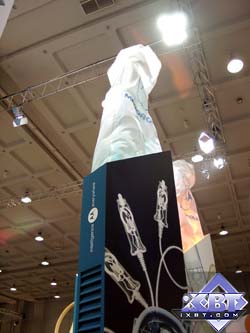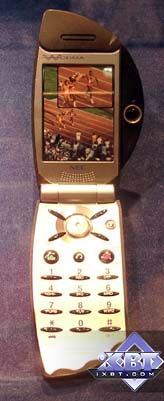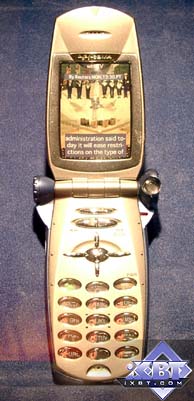 |
||
|
||
| ||
Every time Milan gathers a lot of representatives of telecommunication companies which show their new solutions, in particular, in the sphere of cell phones and networks. This display is often called the most considerable event after CEBIT held in Hannover. SMAU is considered the third or even the second telecommunicational display in the world's table of ranks. Here you can often come across world-famed products which failed to get to CEBIT.  This year the Milan's display sets up new records of attendance as there's not an inch of room near the stands of major companies. Nokia. http://www.nokia.com At the Nokia's stand you could register in the Nokia Club as it brings you some benefit. The 5510 model wasn't unfortunately demonstrated here. This phone meant for youth can be called an SMS communicator as it is equipped with a QWERTY keyboard located around a small screen. By the way, the display is the same as of other models of this company, e.g., Nokia 3310, Nokia 6210. A vibracall is absent, but here you can find a high-quality FM tuner and an embedded MP3- and AAC player with 64 MBytes memory. Reportedly, this model will appear in the first half of the next year at $200-250. Earlier a similar SMS communicator was produced by Motorola (V100) which was aimed at the same sphere, but the sales show that such a phone is not in a great demand.  No prototypes of the business class Nokia 6310 were displayed either. This model differs from its predecessor, 6210, in a dictaphone, improved profiles and an increased battery service life. According to the manufacturer, the phone is able to work up to 20 days, i.e. it can operate during 2 weeks without much problem. The 8310 model which features similar functions but equipped with a usual Li-Ion battery can work up to 4-5 days when used intensively, and even a weeks in case of not many calls. It is the first Nokia's device with the GPRS of Class 4 and which is equipped with a cable for data transfer. This model competes primarily against Siemens S45/ME45 and Motorola T280. Despite the fact that the 6310 is expected not earlier than the beginning of the next year, it can successully beat its cometitors thanks to the aggressive marketing policy. The 6310 did arrive at the display, but it was't shown openly. As it turned out, it was one of the first prototypes. It seems to me that this year the company has shown and promoted only those devices which are already under production. Siemens. http://www.siemens.com Siemens has bring nothing new as well: all the phones are from the current line. It is interesting that the S55 is said to appear in September 2002, and the first specifications, as well as the information on the C55, will be available in March. And now I'm playing with the C45, a middle-level model which is to replace the C35. At the stand there were two color solutions: blue and yellow; the case is redesigned. 
At the same stand I saw new colors for the M35 case, in particular red and yellow, and a new color for the Siemens ME45 - looks quite attractive.    They demonstrated the Siemens SX45 as a phone combined with a PDA which looks fascinating. The woman demonstrating the phone was either a manager solving her problems or a conspiratorial publicity agent. The next day she only spoke over the phone and didn't typed gigantic letters.  Motorola. http://www.motorola.com The Motorola's stand was surrounded by phone's images instead of the screen where they showed one of their models with all its accessories. On the top there were some flags with the company's simbols.   Unfortunately, there was none of the latest solutions, the stand showed only the current line: Motorola v66, T280, T191, T192, T205, Accompli 008. We have already reviewed the most of these models, and the T191 and 008 will soon be available at out site. Sony-Ericsson. http://www.sonyericssonmobile.com The company took two stands in different halls, but both had the simbols of Sony-Ericsson. They displayed the phones which had been already announced - Ericsson T39, T65, T68, R380e, R600, and Sony CMD-Z7, CMD-J7, CMD-J70 and CMD-J6. The most interesting models, R600 and Z7, had only their imitating brothers as there were no working models. The T65 was widely advertised, in Milan this phone is already available at approximately $500. The menu structure is the same, the phone fits my hand excellently, works around 5 days with 10-15 minutes of talking a day. This models looks really great in a blue case.  The T68 is more interesting for me because I haven't exmined it closely before. The color screen is quite pleasant, in all other respects it is a typical phone from Ericsson. At last comes the new version of the Bluetooth garniture from Ericsson, HBH-20. It is priced at $200.  NEC. http://www.nec.co.jp This stand was one of the most interesting as it demonstrated samples of devices of the third generation. Some of them are on the photos. Near the stand there was a big sample with changing images.      There were also devices for the I-mode and FOMA networks.     Among GSM phones there was Nec DB7000. It is one of the biggest clamshell phones since it features plenty of various functions and quite a large sreen. In Europe it will appear on the market in the second half of November at $500-550.   Other displayed models - DB4100, DB4300 and DB6000 - won't be put into production: NEC decided to release only one device, the most attractive in its sector. Sagem. http://www.sagem.com This company demonstrated only one new phone - MW3020, which was described in the latest Digest. All other phones are from the current line.   Many were interested in the WA3050 model which is combined with a PDA. In general, it is quite pleasant except the fact that the monochrome screen doesn't allow using some functions, such as viewing video clips. On the market this model can be purchased at $850-900 which is not an optimal choice as a similar Siemens's handset costs some $700 and has a color display. The only advantage of a monochrome display is a long operating time, but I don't think this model will be successful.  Trium. http://www.trium.net This company produces rather cheap phones equipped with a great deal of functions. They demonstrated all phones from the current series and such new solutions as Trium Aura, Odyssey, Mistra which are similar in functions but different in design. They are the first Trium phones with a packet data transfer (Class 4). Another intriguing model is Trium Eclipse with a color display which has two good games.   One of the stands showed us successful designers' finds:  And the Trium Neptune
with a green transparent flip-flop looks much more attractive than
its analog with a non-transparent one.
Write a comment below. No registration needed!
|
Platform · Video · Multimedia · Mobile · Other || About us & Privacy policy · Twitter · Facebook Copyright © Byrds Research & Publishing, Ltd., 1997–2011. All rights reserved. |